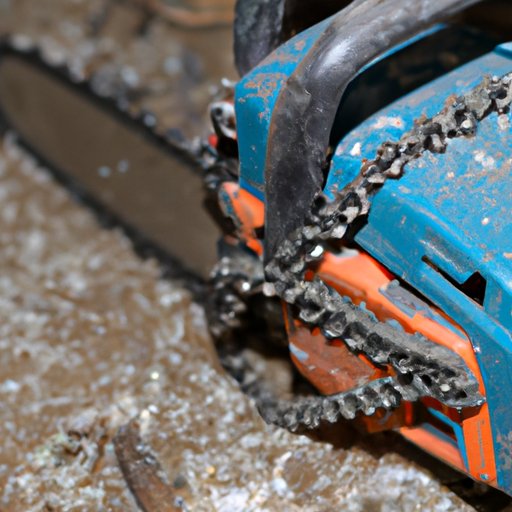
Introduction
Chainsaws are one of the most useful and powerful tools you can have when it comes to heavy-duty cutting jobs. However, a dull chainsaw chain can cause frustration and even be dangerous, putting the operator’s safety at risk. That’s why it is essential to regularly maintain and sharpen your chainsaw chain to extend its lifespan and ensure optimal performance. In this article, we will provide a comprehensive guide on how to sharpen chainsaw chains, as well as tips on maintenance, common mistakes, and tools to use.
Step-by-Step Guide
The first step in sharpening your chainsaw chain is to choose the right sharpener. There are three main types of sharpeners available: manual, electric, and Dremel tool. Manual sharpening is the traditional method of sharpening the chain using a round file. Electric sharpeners offer an easy and efficient way of sharpening chain using a built-in grinding wheel. Finally, Dremel tools are handheld rotary tools that can be helpful for minor touch-ups and repairs.
Manual Sharpening with a Round File
Manual sharpening is a classic method of sharpening chainsaw chains, and it requires a few tools, including a chainsaw file guide, chainsaw file, and a chainsaw file gauge. To sharpen your chainsaw chain manually, follow these steps:
- Secure the chainsaw bar and chain.
- Identify the leading cutter that requires sharpening.
- Use the chainsaw file gauge to determine the correct angle for your file.
- Place your chainsaw file into the groove and begin filing the cutting edge of the chain.
- File in one direction, keeping the same angle throughout the process.
- Repeat the process until the cutting edge appears sharp and shiny.
- Repeat steps 2-6 for all the cutters on the same side of the chain before moving on to the other side.
Electric Sharpening with a Chainsaw Sharpener
Electric sharpeners can make the process of sharpening chainsaw chains quick and straightforward. Here’s how to use an electric chainsaw sharpener:
- Attach the chainsaw chain to the sharpener and adjust the depth gauge.
- Start the sharpener and slowly move the chain back and forth through the sharpener.
- Apply moderate pressure to the chain as you move it through the sharpener, so the grinding wheel has enough material to remove from the chain.
- Remove the chain from the sharpener and inspect it to ensure it’s sharp.
- Adjust the depth gauge if needed and sharpen the other cutters.
Sharpening with a Dremel Tool
Dremel tools are versatile handheld rotary tools that can be used for various jobs, including sharpening chainsaw chains. Here’s how to use a Dremel tool for sharpening a chainsaw chain:
- Attach a grinding stone accessory to your Dremel tool.
- Place the grinding stone into the cutter’s groove.
- Slowly move the Dremel back and forth across the cutting edge while applying enough pressure to remove material from the chain.
- Be sure to maintain a steady angle while you work.
- Repeat the process for all the cutters on the same side of the chain.
Comparison Article
Manual and electric sharpening methods both have their advantages and disadvantages.
Manual vs Electric Sharpening Methods
Manual sharpening is cost-effective and doesn’t require any electricity, so it’s ideal for outdoor use. However, it can be time-consuming and challenging to achieve a consistent angle, which can affect the chain’s performance. Electric sharpeners are efficient and easy to use, requiring little knowledge or expertise. However, they can be expensive and less portable, putting them at a disadvantage in off-grid situations, such as camping.
Factors to Consider When Choosing a Sharpener
When choosing a chainsaw sharpener, consider the following factors:
- The type of saw you use
- The frequency of usage
- Your experience with sharpening
- Portability and ease of use
- Cost
Common Mistakes
Sometimes, even with the best intentions, chainsaw users make mistakes when sharpening their chainsaw chains. Here are some common mistakes you should try to avoid:
- Filing at the wrong angle or depth gauge
- Using the wrong file diameter and not keeping the file level
- Over-filing and removing too much material from the chain
- Not properly cleaning and lubricating the chain after sharpening
To help you avoid these mistakes, make sure you check your chainsaw’s manual or guide to determine the appropriate chainsaw chain sharpening angle and technique.
Video Tutorial
If you’re a visual learner, we have a video tutorial on how to sharpen a chainsaw chain that can give you some extra tips and tricks. Check it out below:
[Video tutorial embedded]
Beginner’s Guide
If you’ve never sharpened a chainsaw chain before, it can be daunting at first. Here are some tips and instructions for beginners:
- Always use safety gear, including gloves and protective eyewear.
- Choose an appropriate location to sharpen your chainsaw chain.
- Identify the right file size for your chainsaw chain, which can be found in your chainsaw manual.
- Understand how to hold the file and which angles to file at.
- Practice filing one cutter at a time before you move on to the sharpener.
Maintenance Tips
Maintaining your chainsaw can help you avoid the hassle of a dull chain and improve its lifespan. Here are some tips:
- Adjust the depth gauge to keep the cutters at the optimal height.
- Check the chain’s tension regularly.
- Keep the chainsaw lubricated and clean after use.
- Check the air filter to ensure it’s not clogged with debris.
- Use the appropriate bar and chain oil and fuel mixture for your chainsaw.
Conclusion
Having a sharp chainsaw chain is crucial for preventing accidents and ensuring optimal performance. Following the steps outlined in this article, you can easily sharpen your chainsaw chains and keep them in good working order. We hope the tips and information provided help you maintain your chainsaw and keep it sharp for years to come.




